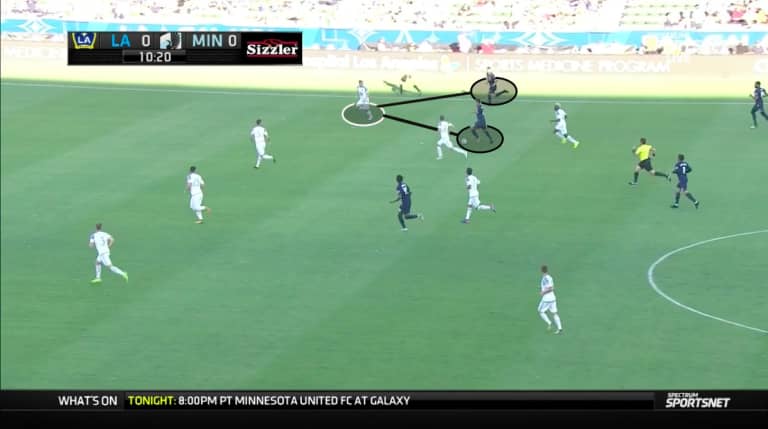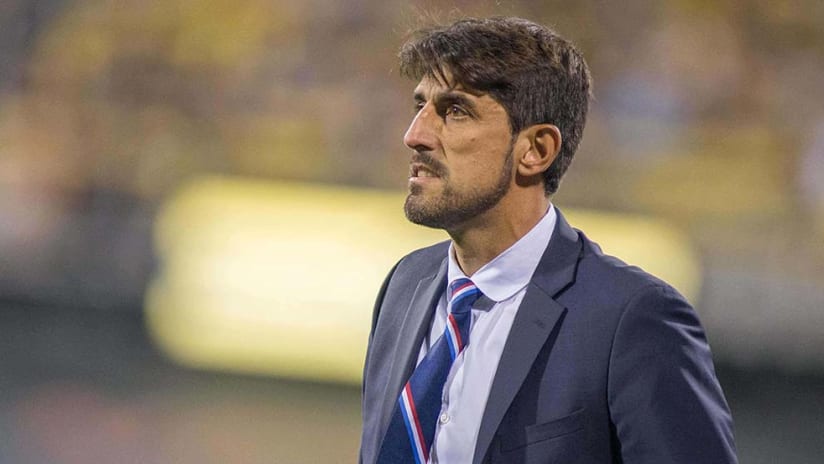Each week, Sam Polak breaks down the top coaching moves in MLS from the previous week. Here are his top five from Week 32.
5. New England’s attacking mentality after going up a man
The New England Revolution went on to beat NYCFC 2-1 Sunday thanks to an adjustment in their mentality. Revs interim head coach Tom Soehn and his staff instilled a different mindset in their side after the dynamics in the match changed with Jack Harrison’s 26th minute red card.
Through the first 25 minutes, NYCFC’s high press and general defensive scheme forced the Revs to need to move the ball quickly when in possession. With their man advantage, they adopted a more patient approach in the attack.
This had multiple effects on the match—the largest being that the Revs offense began to dictate NYC’s defense, a reversal in how the first 25 minutes unfolded. By collectively valuing maintaining possession and showing a more measured desire to probe NYC’s numerically disadvantaged defense, the Revs took the lead in the 51st minute.
When both sides have even numbers, doing the right thing with the ball won’t always result in quality goal scoring opportunities. However, as Tom Soehn and the Revs showed us, by remaining disciplined, focused, and making the correct decisions in an 11v10 situation, you should almost certainly be able to create a number of dangerous chances— just as the Revs did.
4. Porter switching his fullbacks
The Portland Timbers had a dominant outing on Sunday, dismantling D.C. United 4-0. This performance was big heading into the playoffs as they were impressive on both sides of the ball— going on a four-goal rampage while simultaneously preserving a clean sheet. What’s more, both their offensive and defensive feats came in part thanks to Timbers head coach Caleb Porter’s decisions to start Alvas Powell and Vytas at right and left back respectively.
Powell, whose last start was on Aug. 12, and Vytas, who hadn’t started since Sept. 9, rewarded their coaching staff’s decision with their play. The two outside backs were crucial pieces in preventing D.C. from scoring, even keeping their opponents from having a single shot on target until the 36th minute. Powell was also dangerous going forward, and tucked a great goal in off a left footed strike in the 50th minute.
This result from the Timbers was a welcomed change for Caleb Porter and his staff after a 2-1 defeat to the San Jose Earthquakes in their previous game on Sept. 30 (where they also subbed out both of their outside backs, Zarek Valentin and Roy Miller, during that 90 minute contest). The Timbers have a lot of quality individuals and it will be interesting to see how they balance playing time come the playoffs.
3. Houston passing execution
The Houston Dynamo pulled off a crucial midweek comeback win in their quest to stay above the playoff line, getting two goals in the second half on their way to beating Sporting KC. How exactly did Houston pull this off? With the better execution of one specific detail, which head coach Wilmer Cabrera and his staff identified and then corrected between halves.
In the first 45, the Dynamo’s ability to connect passes when trying to progress into the final third or even when they were already in that part of the field was lackluster. Some of the more glaring examples of this are below.
For an upcoming MLS piece: Houston corrected their inability to connect passes in the final 3rd against SKC in the 2nd half-not so much here pic.twitter.com/2KnRkhEk55
— Sam (@11v11Sam) October 17, 2017
Going into the second half, the Dynamo coaching staff addressed this issue. And this was the spark that led to their turnaround in the 63rd minute: cleanly connecting a pass behind SKC’s backline.
Getting on the scoreboard changed the tide of the match, and Houston continued to build on this momentum as they went on to score once more en route to their 2-1 win.
2. Galaxy’s Tactics
Sigi Schmid and his LA Galaxy may have figured out what formation to open next year with given their 3-0 performance against Minnesota United on Sunday. Since taking over in July, Schmid has so far tried various incarnations of a 4-3-3, the 4-2-3-1, a 4-4-2 with a flat midfield, and a 3-5-2.
Setting up in a 4-4-2 diamond as they did against Minnesota, the Galaxy looked as dangerous going forward, if not more dangerous, than at any other point since Schmid was appointed head coach.
This tactical set up did two things for the Galaxy. First, it allowed them to create 2v1’s against Minnesota’s outside backs. Below, we see Giovani dos Santos and Romain Alessandrini creating a difficult situation for the Loons, where Minnesota left back Marc Burch just has to keep backing up until a teammate arrived for support. This is the situation that led to LA’s first and game-winning goal. The Galaxy’s second goal also came from a 2v1 on their right side, but with right back Bradley Diallo joining Alessandrini instead of dos Santos in that instance.

Secondly, in instances where the Galaxy look to outnumber an opponent out wide, the ball is at the feet of some their best players and best decision makers. Emmanuel Boateng, dos Santos, Alessandrini are players any coach in MLS would be happy to have with the ball going into in the final third. Do not be surprised, assuming similar personnel, if this is how the Galaxy are organized to start their 2018 campaign.
1. The Chicago Fire Super Sub
Down 2-1 to the Philadelphia Union at the start of the second half, Chicago Fire head coach Veljko Paunovic made a great substitution bringing on David Accam. Now everyone knows that someone like Accam, with 14 goals and eight assists this year, will be dangerous once the Fire can get him involved in the final third. And Accam did this upon drawing a penalty kick for the Fire’s second goal.
However, credit to the Fire coaching staff as not only did Accam’s arrival make them a more threatening side in the attacking third, but a cleaner and more secure team in both the middle and defensive third, and particularly when in possession as well.
For an upcoming MLS piece: Accam's impact on the game in the middle and defensive third for the Chicago Fire pic.twitter.com/WNHFydqjQl
— Sam (@11v11Sam) October 17, 2017
It was Accam’s decision-making and well-weighted pass out of the middle third that was the catalyst for Chicago’s third and game-winning goal. And, Accam’s contributions to help Chicago get out their defensive third with controlled possession (something the Fire were missing, especially in the end of the first half) were invaluable.
Although the Fire defense deserves credit for holding the Union to just a single shot in the latter 45, a portion of that also goes to the stability Accam brought to the Fire while they had possession of the ball. Veljko Paunovic’s use of Accam was a sophisticated substitution in that it gave the Fire an extra dimension going forward and more security when in possession in vulnerable parts of the field or crucial moments of their build up.













